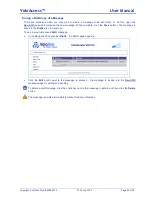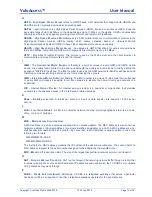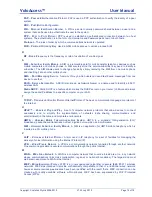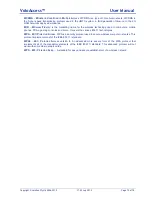
VoloAccess™
User Manual
Copyright © Vololink Pty Ltd 2006-2010
V1.43 July 2010
Page 74 of 78
PAP
–
P
assword
A
uthentication
P
rotocol. PAP is used in PPP authentication to verify the identity of a peer
system.
PBC
–
P
ush
B
utton
C
onfiguration.
PIN
–
P
ersonal
I
dentification
N
umber. A PIN is a secret numeric password shared between a user and a
system that can be used to authenticate the user to the system.
PPP
–
P
oint to
P
oint
P
rotocol. PPP is used to establish an authenticated connection between two host
systems. The authentication is in the form of a Username and Password pair known to both hosts.
Protocol
– The rules of order by which a communications network is operated.
PUK
–
P
ersonal
U
nlocking
K
ey. Used in GSM mobile phones to unlock a locked SIM.
R
RF
–
R
adio
F
requency is the frequency or rate of oscillation of a radio signal.
S
SIM
–
S
ubscriber
I
dentity
M
odule. A SIM is a removable card for mobile cellular telephony devices such as
mobile computers and mobile phones. A SIM securely store the service-subscriber key used to identify a
subscriber. The SIM allows users to change phones by simply removing the SIM from one mobile phone
and inserting it into another mobile phone.
SMS
–
S
hort
M
essaging
S
ervice. A service through which users can send text based messages from one
device to another.
SSID
–
S
ervice
S
et
I
dentifier. A SSID (also known as Network Name) is a name used to identify a 802.11
wireless LAN.
Static DHCP
- Static DHCP is a feature which makes the DHCP server on your router (VoloAccess) always
assign the same IP address to a specific computer on your LAN.
T
TCP/IP
–
T
ransmission
C
ontrol
P
rotocol/
I
nternet
P
rotocol. The basic communication language or protocol of
the Internet.
U
UPnP™
–
U
niversal
P
lug
a
n
d
P
lay. A set of computer network protocols that allow devices to connect
seamlessly and to simplify the implementation of networks (data sharing, communications, and
entertainment) in the home and corporate environments.
UMTS
–
U
niversal
M
obile
T
elecommunications
S
ystem. UMTS is a so-called 'third-generation (3G),'
broadband, packet-based transmission of text, digitised voice, video, and multimedia.
SIM
–
U
niversal
S
ubscriber
I
dentity
M
odule. A SIM is an application for UMTS mobile telephony which is
inserted in a 3G mobile phone.
V
VoIP
–
V
oice
o
ver
I
nternet
P
rotocol. A term used in IP telephony for a set of facilities for managing the
delivery
of voice
information using the Internet Protocol (IP).
VPN
–
V
irtual
P
rivate
N
etwork. A VPN is a communications network tunnelled through another network.
One common application is secure communications through the public Internet.
W
WAN
– W
ide
A
rea
N
etwork. A WAN is a computer network that covers a broad area (i.e., any network
whose communications links cross metropolitan, regional, or national boundaries). The largest and most
well-known example of a WAN is the Internet.
WEP
– W
ired
E
quivalent
P
rivacy. WEP is a (now superseded) algorithm to secure IEEE 802.11 wireless
networks. WEP was intended to provide confidentiality comparable to that of a traditional wired network;
however several serious weaknesses have been identified with the result that a WEP connection can be
cracked with readily available software within minutes. WEP has been superseded by Wi-Fi Protected
Access (WPA).




































